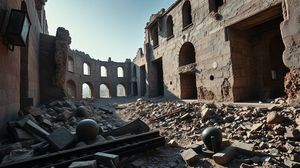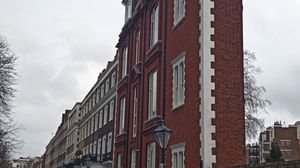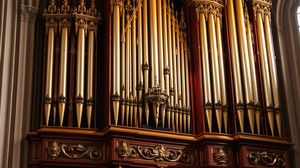
London's landscape bears the enduring marks of World War II, offering a poignant journey through history for those who seek it. The city, once under the relentless assault of the Blitz, still showcases remnants of bomb damage that have been preserved or integrated into the urban environment.
At the Victoria and Albert Museum, visitors can observe subtle traces of wartime damage. Though largely restored, some scars remain on the façade, serving as a silent testament to the resilience of the institution and the city.
Christ Church Greyfriars, near St Paul's Cathedral, stands as a haunting reminder of the war's devastation. The ruins of this medieval church, destroyed during the Blitz, have been transformed into a public garden, with the surviving walls embracing a space of reflection and tranquility.
Throughout London, attentive eyes may notice modern houses nestled between older terraces. These buildings often fill the gaps left by bombs that destroyed individual homes, creating a patchwork of architectural styles that tells the story of loss and regeneration.
In some areas, open green spaces hint at the past locations of buildings lost to bombings.
The Imperial War Museum itself occupies a building with its own wartime history, offering extensive exhibitions on the Blitz and housing artifacts that provide deeper insights into the impact of the war on London and its inhabitants.
St Dunstan-in-the-East, another church destroyed in the Blitz, has been converted into a public garden. The ruins and overgrown greenery create a surreal and beautiful space, demonstrating how destruction has been transformed into a place of peace.
Walking through the city, one might find plaques and markers indicating sites of significant bomb damage. These often-overlooked details enrich the experience of exploring London, connecting present-day streets with their wartime past.
The Temple Church area also suffered damage, with parts of the church rebuilt after the war. The blend of old and new stonework illustrates the efforts to restore and preserve London's historical architecture.

Making the Most of Your Visit:
Notice the mix of architecture as you wander around London – the variety of architectural styles often indicates where bombs destroyed original buildings. It's a subtle way the city tells its own story of recovery and resilience.
When visiting Christ Church Greyfriars, take a moment to appreciate how the remaining walls envelop a serene garden space. The juxtaposition of the old stonework with vibrant flora is an evocative testament to rebirth.
At the Imperial War Museum, ensure you visit the Blitz exhibit. It provides a contextual backdrop to the scattered evidence of bomb damage you'll spot around the city, making these encounters much more meaningful.
St Dunstan-in-the-East is a beautiful contrast between ruin and nature. Try visiting at different times of the day to feel the changing atmosphere; early mornings can be especially tranquil.
When in the vicinity of the Victoria and Albert Museum, look closely at the façade for signs of wartime scars. These details are easy to miss but offer a tangible connection to the city's history.

Visiting Times & Costs:
The "World War II Bomb Damage, Various Locations" refers to multiple sites across London where remnants and scars of wartime impact can still be seen. These locations are openly accessible to the public year-round as part of the city's urban landscape.
Opening Times:
- Open to the public at all times as these are part of the general city environment.
Cost:
- Free to explore, as these locations are part of public spaces and streets.
Accessibility:
- Varies by location. Many sites, such as public gardens at the ruins of churches and plaques on streets, are generally accessible to those with mobility issues. However, the accessibility of specific sites can depend on factors such as urban footpath conditions and garden access points.
Visitors are encouraged to explore at their own pace, noting the subtle reminders of history interwoven with the city's modern identity.

Address & Map:

Nearby:























